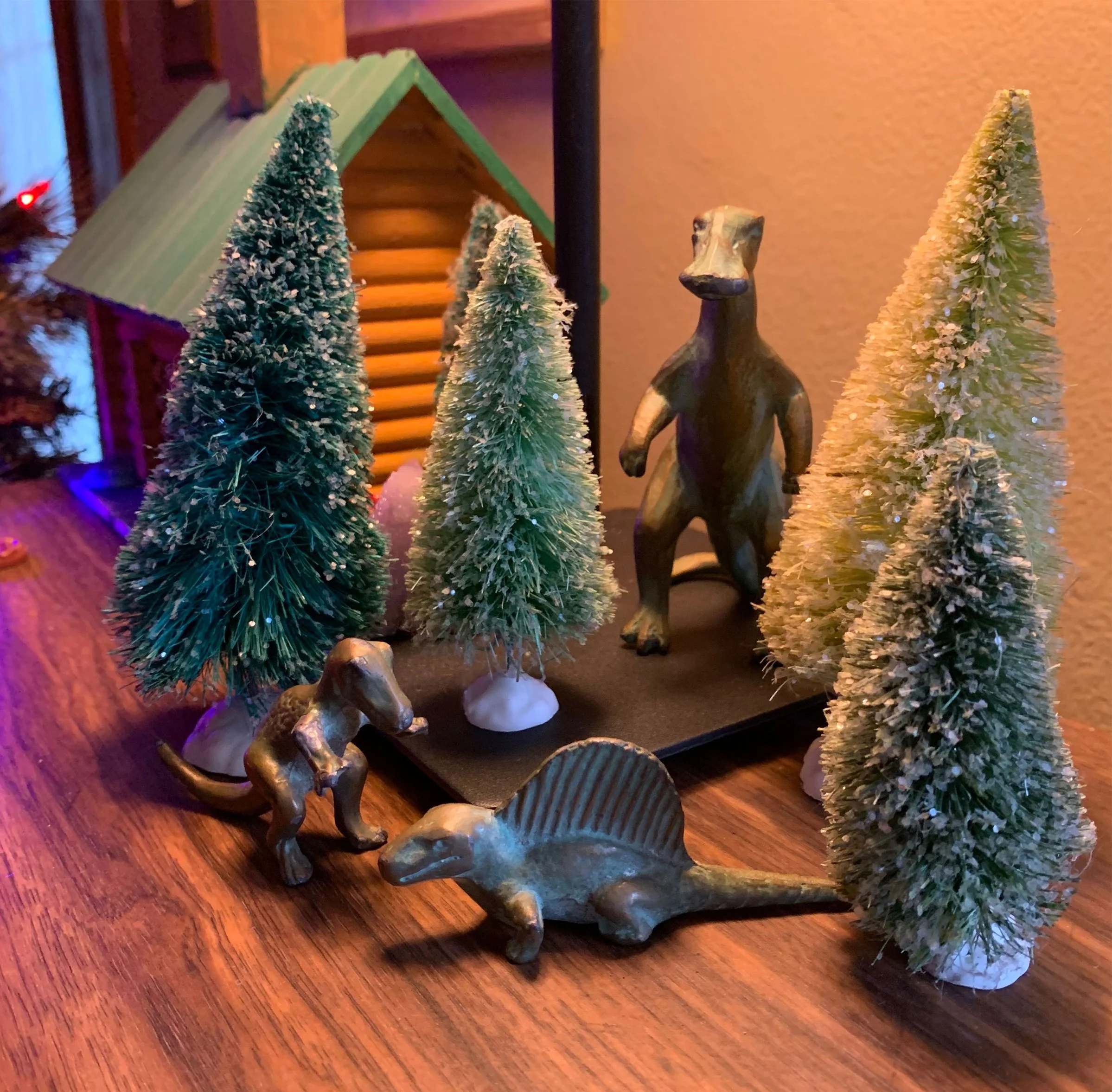Time Travel: Exit Through the Gift Shop
By Sue Lawton
A “Trachodon” model (with a turtle friend) manufactured by Sell Rite Gifts Co. circa 1947.
No trip to the museum would be complete without stopping in the gift shop. I clearly remember my first visit to Milwaukee Public Museum in my early childhood (the early 80’s) and how excited I was to get a dinosaur coloring book. I spent hours flipping through the pages, learning all the dinosaur names and carefully coloring them in with whatever colors my imagination desired.
At a recent family gathering, I was thrilled and honored to be re-gifted the childhood gift shop experience of my father-in-law, Chuck Sr. He handed me a small, but very heavy cardboard box, along with a card telling the story of the contents within. It starts out “This gift I’m giving you is very dear to my heart. When I was a child of 7 or 8 years of age, I fell in love with the items contained in this box.”
The box was filled to the brim with small tissue paper bundles. As I carefully unwrapped them, each item was an absolute delight! I found many dinosaurs, marine reptiles, a pterosaur, a mammoth, Dimetrodon, and (inexplicably) one little turtle. All are cast in metal with a brass-like finish and soft green patina.
Stegosaurus, Dimetrodon, and two Triceratops (Left) A very cute sauropod and a tiny T-rex with freakishly large hands (right)
“They were selling them at the Old Milwaukee Museum gift shop,” the card continues. “I would save my allowances for weeks until I had enough to buy one. So I’d take the bus into downtown Milwaukee to the museum (now the Library) and pick one out to bring home.”
The MPM of his childhood was on the top floor of Milwaukee’s Central Library. As we prepare to see the current museum move to a new location, it’s particularly salient to remember the previous versions and what they meant to older generations.
A beautiful Mosasaurus (left) and the information on the bottom of a Plesiosaurus (right)
After getting the figures home, I did some research using the markings on the bottoms of some of them. It turns out they were manufactured by Sell Rite Gifts Co. from 1947-1955 and were only sold in museum gift shops. They are likely made of a lead-based metal with a brass finish (so I’ll be handling them with gloves from now on). According to Dino Toy Blog and other collectors I found online, these were likely the first mass-produced dinosaur models available to the public. They not only offer us a mode of time travel in thinking about the old public museum, but also in how people imagined dinosaurs and other extinct animals in the past. More recent science and popular cultural representations have changed our ideas of how these creatures may have looked and moved.
Each SRG figure would have come with a small information card, which Chuck Sr. no longer has. I did find them online and was happy to identify the large, upright dinosaur as a “Trachodon”. This was a genus of hadrosaur (duck-billed dinosaur) discovered early on in paleontological history (1850’s). As can happen with some of these early discoveries, conflicting information, renaming, and differing categorizations have left “Trachodon” as a dubious genus. This means all or most of the specimens that were previously labeled as Trachodons have since been relegated as other kinds of hadrosaurs. If you want to learn more about the lengthy and confusing history of hadrosaur taxonomy, I suggest you listen to the I Know Dino podcast episode 350: “Hadrosaur Hootenanny”. Whatever you want to call this particular dinosaur, the SRG depiction has an outdated upright pose, using its hind limbs and tail as a sort of tripod. It is now believed that this type of dinosaur would have been primarily quadrupedal (moving around on four limbs) with its tail sticking straight out behind it, rather than dragging on the ground.
Similarly, the tiny Tyrannosaurus is shown in the same tripod pose. Again, modern paleontologists tend to view dinosaurs as active animals, more bird-like and less like tail-dragging lizards. While T-rex is still believed to be bipedal, it would have had a less upright pose and the muscular tail would have stuck out behind it as a counter balance. It’s also strange that the T-rex is depicted with proportionally large hands with three digits. It would have been known at that time that they only had two digits and that their arms were humorously tiny.
A gigantic, dubious Trachodon looks on as a tiny, large-handed T-Rex attacks a Permian synapsid, Dimetrodon. In other words, none of this makes sense and you should probably stay inside the cabin.
Overall, this was such a perfect and surprising gift considering my ongoing interest in paleontology and the Milwaukee Public Museum. It’s even more special because it’s a piece of family history as well. I can’t wait to make these diminutive critters a proper display, perhaps a miniature MPM-style diorama!



